| Srl | Item |
| 1 |
ID:
134047
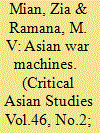

|
|
|
|
|
| Publication |
2014.
|
| Summary/Abstract |
The South Asian security landscape is increasingly dominated by a complex four-way dynamic between India, Pakistan, China, and the United States. The stresses and strains of the relationships between these states directly affect the prospects for peace and prosperity for almost half of humanity. This article describes some of the military contours of this landscape, with a focus on strategic postures, weapon acquisitions, and the role of nuclear weapons. It maps the India-Pakistan arms race over the past decade, the economic constraints on the two states, the role of China and the United States as weapons suppliers, and the risk and consequences for nuclear war. The authors then look at India's relationship with China, which is marked by both cooperation and competition, and the rise of China as a close military, political, and economic ally of Pakistan. While the United States has had long-standing cooperative relationships with both India and Pakistan, these relationships have been undergoing major shifts over the last two decades. U.S. concerns about China's increasing military and economic power have also intensified over this period as well. Of particular significance has been the effort to create a U.S.-India strategic partnership to balance and contain a rising China, which may become a central feature of the emerging global order. This article also offers a brief overview of what is publicly known about the nuclear arsenals of the four countries, ongoing production of weapons-usable fissile materials in Pakistan and India, as well as the race to build longer-range missiles.
|
|
|
|
|
|
|
|
|
|
|
|
|
|
|
|
| 2 |
ID:
059656


|
|
|
| 3 |
ID:
061156
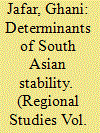

|
|
|
|
|
| Publication |
Winter 2004-05.
|
|
|
|
|
|
|
|
|
|
|
|
|
|
|
|
| 4 |
ID:
053902


|
|
|
| 5 |
ID:
063555
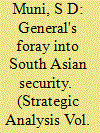

|
|
|
| 6 |
ID:
093988
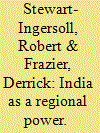

|
|
|
|
|
| Publication |
2010.
|
| Summary/Abstract |
The Regional Powers and Security Framework provides a systematic method to assess how the relative strength and behavior of regional powers influence regional security orders. This article applies the framework to India as a South Asian regional power. The analysis indicates that although the region is unipolar; India's impact is limited because of its failure to play leadership and custodianship roles. It does serve as a protector of the region from external threats, doing so through a unilateral, status quo, and reactive orientation. Application of this framework points to a lack of a hegemonic security order in South Asia, in spite of India's self-view as the region's natural hegemon. For India to be hegemonic, it would have to play these roles in a comprehensive manner.
|
|
|
|
|
|
|
|
|
|
|
|
|
|
|
|
| 7 |
ID:
134111
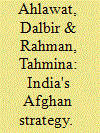

|
|
|
|
|
| Publication |
2014.
|
| Summary/Abstract |
With the deadline for the US withdrawal from Afghanistan getting closer, regional and extra-regional states have indicated pivoting their Afghan strategy. India, being an emerging power, holds much potential to contribute to the stabilisation and reconstruction of war-torn Afghanistan by developing strategic partnership with other stakeholders. For this, India's status in the regional and international system, its economic and military might and its strategy to reach beyond its traditional zone of influence warrant a systemic analysis of its Afghan strategy. The article traces the antecedents of India's current strategic and foreign policy in classical Indian strategic text Arthashstra and analyses India's present level of involvement in Afghanistan in the light of that discussion. An attempt is made in this paper to show how India's Afghan strategy is informed and influenced by its perception of allies, enemies and indifferent big powers. The paper also suggests some policy changes by critically assessing the broader context in which India operates today.
|
|
|
|
|
|
|
|
|
|
|
|
|
|
|
|
| 8 |
ID:
064045


|
|
|
| 9 |
ID:
107150
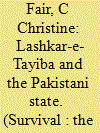

|
|
|
|
|
| Publication |
2011.
|
| Summary/Abstract |
Lashkar-e-Tayiba (LeT) is the most lethal terrorist group operating from South Asia. Founded in 1989 in Afghanistan with help from Pakistan's Inter-Services Intelligence (ISI), it began operations in India in 1990. Until November 2008, US policymakers tended to dismiss LeT as India's problem, despite the fact that the group had been attacking US troops and their international and Afghan allies in Afghanistan. On 26 November 2008, however, LeT made its debut as an international terrorist organisation when it launched a four-day siege of India's port city of Mumbai. In that attack, 166 people perished, including several Americans and Israelis. This was the first time that LeT had targeted non-Indian civilians. Recent revelations that David Coleman Headley, an American citizen of Pakistani origin, conspired with LeT (and, allegedly, a Pakistani army major deputed to the ISI) to launch the Mumbai offensive have stoked fears about American home-grown terrorism and the ability of LeT to attack the US homeland. Headley's ties to an al-Qaeda leader, Ilyas Kashmiri, have furthered speculation about LeT's ties to al-Qaeda. Rightly or wrongly, some American officials believe it is only a matter of time beforeLeT will launch an attack on US soil.
|
|
|
|
|
|
|
|
|
|
|
|
|
|
|
|
| 10 |
ID:
054818


|
|
|
| 11 |
ID:
058427


|
|
|
| 12 |
ID:
058771


|
|
|
| 13 |
ID:
057410


|
|
|
| 14 |
ID:
063686


|
|
|
| 15 |
ID:
063945


|
|
|
| 16 |
ID:
168632
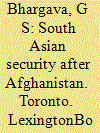

|
|
|
|
|
| Publication |
Toronto, LexingtonBooks, 1983.
|
| Description |
vii, 198p.hbk
|
| Standard Number |
0669055573
|
|
|
|
|
|
|
|
|
|
|
|
Copies: C:1/I:0,R:0,Q:0
Circulation
| Accession# | Call# | Current Location | Status | Policy | Location |
| 022179 | 958.1044/BHA 022179 | Main | On Shelf | General | |
|
|
|
|
| 17 |
ID:
094673
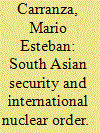

|
|
|
|
|
| Publication |
Surrey, Ashgate, 2009.
|
| Description |
xiv, 198p.
|
| Standard Number |
9780754675419
|
|
|
|
|
|
|
|
|
|
|
|
Copies: C:1/I:0,R:0,Q:0
Circulation
| Accession# | Call# | Current Location | Status | Policy | Location |
| 054860 | 327.17470954/CAR 054860 | Main | On Shelf | General | |
|
|
|
|